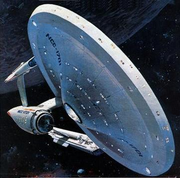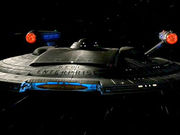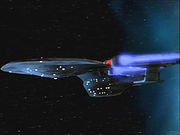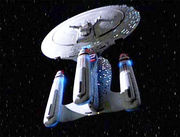Starship Enterprise
| First appearance | Star Trek, September 8, 1966 |
|---|---|
| Affiliation | United Federation of Planets Starfleet |
The Enterprise or USS Enterprise (often referred to as the "Starship Enterprise") is the name of several fictional starships, some of which are the focal point for various television series and films in the Star Trek franchise created by Gene Roddenberry.[1] The majority of these vessels share "NCC-1701" as part of their registry, with later ships appending a letter to the registry to differentiate them.[1]
Contents |
Enterprise history
The name Enterprise comes from a long series of ships. The first was the French frigate L'Entreprise, captured by the British in 1705. The British rechristened the ship HMS Enterprise for use by the Royal Navy. A further nine Royal Navy commissioned warships carried the name "Enterprise". The first United States ship to use the name USS Enterprise was a Revolutionary War-era sloop-of-war. The eighth American ship to bear this name was the world's first nuclear aircraft carrier.
Development


According to The Star Trek Encyclopedia, the registry number "NCC-1701" was devised by Matt Jefferies, art director of the first Star Trek series, inspired by an old science fiction cover that Gene Roddenberry liked, with a starship flying through space. Jefferies, who is a pilot, based NCC on 20th century aircraft registration codes. In such 20th century usage, an "N" first letter refers to an aircraft registered in the USA. A "C" for a second letter refers to a civil aircraft. Jefferies added a second "C", just because he thought it looked better.[1]
The Franz Joseph Blueprints and a handful of Star Trek novels state that NCC is an initialism for "Naval Construction Contract".
In Gene Roddenberry's original Star Trek pitch, the starship is described as a "United Space Ship," and in two episodes of the original series (TOS), Kirk refers to the "United Space Ship Enterprise".
Star Trek: Phase II
Before Star Trek: The Motion Picture, Paramount had planned a new Star Trek television series to have been named Star Trek: Phase II. Early in the production, Ralph McQuarrie had been hired to redesign the ship. The major feature of the redesign was to replace the cigar-shaped secondary hull with a larger, triangle-shaped section. McQuarrie's design was discarded in favor of keeping the general shape of the ship intact.
Depiction
Pre-Federation era
Two Enterprises predate the United Federation of Planets.
.jpg)
Registry: USS Enterprise (XCV 330)
Class: Declaration
Service: circa 2130s
Captain: Unknown
This USS Enterprise (XCV 330) appears in Star Trek: The Motion Picture among a series of illustrations depicting ships named Enterprise. The 1979 Star Trek Spaceflight Chronology describes this "first interstellar liner" as a Declaration-class ship launched in 2123.[2]

Registry: Enterprise (NX-01)
Class: NX
Service: 2151 – 2161
Captain: Jonathan Archer (Scott Bakula)
The United Earth Starfleet's Enterprise is the main setting of Star Trek: Enterprise.
The Original Series era
Three ships named USS Enterprise are featured in the original Star Trek television series and the first through seventh Star Trek films.
,_ENT1231.jpg)
Registry: USS Enterprise (NCC-1701)
Class: Constitution
Service: 2245 – 2285
Captains: Robert April (James Doohan, Gene Roddenberry), Christopher Pike (Jeffrey Hunter), James T. Kirk (William Shatner), Willard Decker (Stephen Collins) (refit), Spock (Leonard Nimoy) (refit)
The Federation's first Enterprise is the main setting of the original Star Trek series (1966–1969) and The Animated Series (1973–74).[3] A refitted Enterprise appears in Star Trek: The Motion Picture (1979) and Star Trek II: The Wrath of Khan (1982), before being destroyed in Star Trek III: The Search for Spock (1984).[3]
.jpg)
Registry: USS Enterprise (NCC-1701-A)
Class: Constitution refit
Service: 2286 – 2293
Captain: James T. Kirk (William Shatner)
This ship first appears at the end of Star Trek IV: The Voyage Home (1986) and is the main setting of Star Trek V: The Final Frontier (1989) and Star Trek VI: The Undiscovered Country (1991).[3] The ship is ordered decommissioned at the end of The Undiscovered Country.[3] Paperwork included with the model kit indicated the ship was mothballed at the Memory Alpha ship museum, and William Shatner's novel The Ashes of Eden (1996) depicts the Enterprise-A's removal from the mothball fleet before being destroyed defending the planet Chal.

Registry: USS Enterprise (NCC-1701-B)
Class: Excelsior refit[4]
Service: 2293 – 2320s
Captain: John Harriman (Alan Ruck)
Launched at the start of Star Trek Generations (1994).[1] James T. Kirk goes missing during the ship's maiden voyage.[1] According to Star Trek novels, Demora Sulu becomes captain after Harriman.
The Next Generation era
Three ships named Enterprise are featured in Star Trek: The Next Generation and four TNG-era films.

Registry: USS Enterprise (NCC-1701-C)
Class: Ambassador
Service: 2332[5] – 2344
Captain: Rachel Garrett (Tricia O'Neil)
This ship appears in the Next Generation episode "Yesterday's Enterprise" (1990).[1] It was destroyed attempting to defend the Klingon outpost Narendra III from Romulan attack.[1] Survivors included Tasha Yar (Denise Crosby), whose alternate timeline version from "Yesterday's Enterprise" travels with the ship back in time to the battle over Narendra III.[1] The actions of the Enterprise-C's crew became a catalyst for the alliance between the Federation and the Klingon Empire.[1]

Registry: USS Enterprise (NCC-1701-D)
Class: Galaxy
Service: 2363 – 2371
Captains: Jean-Luc Picard (Patrick Stewart), William Riker (Jonathan Frakes), Edward Jellico (Ronny Cox)
The main setting of Star Trek: The Next Generation (1987–1994).[1] The Enterprise was lost in 2371 after an attack by a renegade Klingon Bird-of-Prey (commanded by the Duras sisters) caused extensive damage, leading to a warp core breach. Although the saucer section was safely separated before the breach, the shock wave from the explosion caused it to crash land on Veridian III. The ship was not salvageable. This takes place during Star Trek Generations[1]

Registry: USS Enterprise (NCC-1701-E)
Class: Sovereign
Service: 2372 – Active (as of 2387)
Captain: Jean-Luc Picard, Data (Brent Spiner)
The main setting for the films Star Trek: First Contact (1996), Star Trek: Insurrection (1998), and Star Trek Nemesis (2002).[1][6]
Alternate timelines
Alternate Future

Registry: USS Enterprise (NCC-1701-D)
Class: Galaxy Refit
Service: 2363-Unknown
Captain: Admiral William T. Riker
In "All Good Things...", the final episode of Star Trek: The Next Generation, the Enterprise-D was shown in an alternate future where it had been refitted to include a third nacelle, cloaking ability and large phaser cannons on the saucer section.

Registry: USS Enterprise (NCC-1701-J)
Class: Universe
Service: 26th Century
Captain(s): Unknown
The "Azati Prime" episode of Star Trek: Enterprise involves time travel and features a scene in which the Enterprise-J appears. The Enterprise-J operates in one possible version of the 26th century. [7]
Mirror Universe
The Mirror Universe first appeared in the original series as reality where a militaristic empire exists in place of the regular universe's United Federation of Planets. Subsequent episodes have shown that the divergence at least predates the Moon landing, with licensed novels putting the divergence before Shakespeare, or even classic Greek literature.
.jpg)
Registry: ISS Enterprise (NX-01)
Class: NX
Service: 2150s
Captains: Maximilian Forrest (Vaughn Armstrong), Jonathan Archer
The Star Trek: Enterprise episode "In a Mirror, Darkly" features a Mirror Universe version of the NX-01 Enterprise. This ship is equipped with a cloaking device, deflector shields, a tractor beam, a prototype Agony Booth, and different exterior markings. It is commanded by Captain Maximilian Forrest, although for a brief time his first officer, Commander Jonathan Archer, takes command following a mutiny. This Enterprise is destroyed by the Tholians.
.jpg)
Registry: ISS Enterprise (NCC-1701)
Class: Constitution
Service: 2260s
Captains: Christopher Pike, James T. Kirk, Spock
A Mirror Universe Enterprise appears in the original Star Trek episode "Mirror, Mirror".[3] The ship is equipped with an agony booth and the mirror Captain Kirk's deadly Tantalus device.[3] The ISS Enterprise was originally the same shooting model as the regular Enterprise.[3] The remastered version of "Mirror, Mirror" includes a CGI version of Enterprise with "ISS" markings on the hull and minor physical differences from USS Enterprise, such as a larger deflector dish, a taller bridge, and altered nacelle details.[8]
Altered reality timeline
The 2009 Star Trek film takes place in an altered reality created when the Romulan character Nero traveled through time via a black hole. It is also the expected setting of the next film in the series.

Registry: USS Enterprise (NCC-1701)
Class: Constitution
Service: 2258—
Captains: Christopher Pike (Bruce Greenwood), Spock (Zachary Quinto), James T. Kirk (Chris Pine)
Measurements for this version's final size range from 610 meters to 910 meters.[9][10][11][12] In an interview in Cinefex magazine #118, Industrial Light & Magic Art Director Alex Jaeger discussed the design's growth in size during early production of the film, saying "The reconfigured ship was a larger vessel than previous manifestations – approximately 1,200 feet (370 m) long compared to the 947 foot (289 m) ship of the original series. Once we got the ship built and started putting it in environments it felt too small. The shuttle bay gave us a clear relative scale – shuttles initially appeared much bigger than we had imagined – so we bumped up the Enterprise scale, which gave her a grander feel and allowed us to include more detail." A special feature on starships in the Blu-ray Disc (BD) version of the movie gives the length as 2,379 feet (725 m).
Reception and impact
As the result of a successful letter writing campaign, NASA named the initial flight-test Space Shuttle Enterprise.[1] In 1994, the real aircraft carrier Enterprise hosted a Star Trek convention, and Star Trek memorabilia can be found throughout the ship.
See also
- Virgin Galactic's VSS Enterprise, proposed first commercial spacecraft, named after the Star Trek vessels.
References
- ↑ 1.00 1.01 1.02 1.03 1.04 1.05 1.06 1.07 1.08 1.09 1.10 1.11 1.12 Okuda, Michael; Denise Okuda and Debbie Mirek (1999). The Star Trek Encyclopedia. Pocket Books. ISBN 0-671-53609-5.
- ↑ Goldstein, Stan; Fred Goldstein and Rick Sternbach (1980). Star Trek, Spaceflight Chronology: The Human Adventure Beyond Our World--from the First Small Steps to the Voyage of the New U.S.S. Enterprise in the Twenty-Third Century. New York: Pocket Books. p. 112.
- ↑ 3.0 3.1 3.2 3.3 3.4 3.5 3.6 Asherman, Alan (1993-05-01). The Star Trek Compendium. ISBN 978-0671796129.
- ↑ "Enterprise-B, U.S.S.". CBS Paramount. http://www.startrek.com/database_article/enterprise-b. Retrieved 2009-05-20. "An upgrade of the Excelsior-class"
- ↑ Bick, Ilsa J. (11 2003). Star Trek: The Lost Era: Well of Souls. Pocket Books. ISBN 0-7434-6375-7.
- ↑ "U.S.S. Enterprise-E". Viacom. http://www.startrek.com/database_article/enterprise-e-u-s-s. Retrieved 2009-02-13.
- ↑ Star Trek Azati Prime
- ↑ Sternbach, Rick (November 16, 2006). "Review of Mirror Mirror Remastered". TrekMovie.com. http://trekmovie.com/2006/11/16/review-of-mirror-mirror-remastered/.
- ↑ McGorry, Ken (May 1, 2009). "Cover Story: 'Star Trek' Returns". Post magazine. http://www.postmagazine.com/ME2/dirmod.asp?sid=&nm=&type=Publishing&mod=Publications::Article&mid=8F3A7027421841978F18BE895F87F791&tier=4&id=C0928902C93D4F8682FB2117F7DD841F. "The Enterprise is 3,000 feet (910 m) long but bad guy Eric Bana's ship is designed to appear a humongous five miles long." (Quote from Russell Earl, co-VFX supervisor for ILM.)
- ↑ Robertson, Barbara (May 13, 2009). "Reinventing Star Trek's VFX". Film & Video. http://www.studiodaily.com/filmandvideo/currentissue/Reinventing-Star-Treks-VFX_10905.html. "The Narada was six miles long and the Enterprise is 2,000 feet (610 m)." (Quote from Bruce Holcomb, Digital Model Supervisor for Star Trek.)
- ↑ Dunlop, Renee (May 26, 2009). "Star Trek: Production Focus". CCGSociety. http://features.cgsociety.org/story_custom.php?story_id=5071. "One challenge was to sell the weight and scale of the ships that ranged from a 30 foot shuttle to the new Enterprise at 2,357 feet (718 m) long, to the nemesis ship, the Narada, five miles long." (Source Russell Earl & Roger Guyett, co-VFX Supervisors at ILM.)
- ↑ "Experience the Enterprise". Paramount Pictures & CBS Studios Inc.. http://www.experience-the-enterprise.com/. "Length: 2,500 feet (760 m)."
External links
- USS Enterprise at Memory Alpha (a Star Trek wiki)
- ISS Enterprise at Memory Alpha (a Star Trek wiki)
- NASA link on the naming of the first Space Shuttle
- Star Trek Fans and Stars Visit Real USS Enterprise, US Navy press release
- Carrier Enterprise Meets Starship Enterprise, The Virginian-Pilot, Oct. 28, 1994
|
||||||||||||||||||||||||||||||||||||||||||||||||||||||||||||||
| Spacecraft named Enterprise |
|---|
| NASA Space Shuttle (1976–1985) • Virgin Space Ship (2009—) • Star Trek starships (Fictional) |
|
|||||||||||